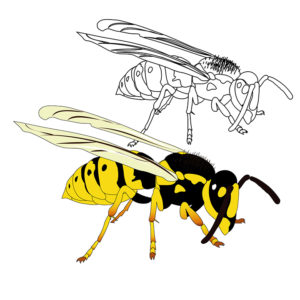Q. Last year, I discovered a bee hive in a juniper bush. In January, I hosed it down with a high-pressure nozzle. I think I destroyed the hive or maybe it got too cold as I see no evidence of any activity. What can I do to make sure they don’t return and reestablish the hive? 
A. Honey and Bumble Bees along with Wasps are inactive during cool, wet weather but if disturbed, they will fly around and sting. On the other hand, a Yellow Jacket hive is empty or abandoned. In late November, the worker and male Yellow Jackets after mating with the queen(s) die. Shortly after that the queen(s), abandons the old hive and hibernates in the bark of trees and or logs. So, I believe you had a Yellow Jacket hive. It may be a bit early, but the Queens should emerge from hibernation and start looking to establish new nesting areas within the next three weeks. Also, there is almost no chance of a queen reoccupying an old site. Yellow Jackets establish hives under the ground in abandon gopher or other rodent holes. The above ground nests are close to structures like under the eves of a house or in ornamental bushes like junipers. The hives start slowly, reaching their peak in September/October. Yellow Jackets rarely are a problem at Memorial Day, more problematical by the 4th of July and a huge nuisance by Labor Day. In the fall they’re easily agitated as mating season approaches. The hives remain active until November when the process begins or ends again depending on how you look at it. Your best defense against a Yellow Jacket establishing a hive in your yard is to trap the queens early on. I’d reuse my Yellow Jacket Traps from previous years. But first washed them out with warm soapy water before adding any new attractant. Because of the very wet January and February, I expect the Yellow Jacket population to be smaller than previous years as a significant number of queens did not survive.
Q. Three years ago, we planted several English Lavender plants. They are full and bushy, but they get no water except when we periodically drag a hose to them. Right now, they get a lot of wear and tear from neglect. Should the flowers be trimmed off after blooming and when is the best time to shape these plants?
A. The old spent Lavender flowers should be removed along with the stems after blooming. The plant then could be lightly trimmed with a pair of hedge shears but don’t prune them back to bare stems. In most gardens, Lavender plants have a short life span of no more than five years. In our clay soil, the primary problem is the companion plants mixed with the Lavenders. These plants require much more water and fertilizer while lavender plants thrive on neglect. So, I wouldn’t change a thing you are currently doing or suggest anything different.
Q. I have a very old Clematis plant with three-inch fragrant white flowers that always start blooming in mid-February on the new growth. The leaves are six to seven inches long and are a dark green color, so I’m confused when I read that the spring blooming varieties bloom only on the old wood. What type of Clematis do I have?
A. I believe you have Clematis Armandii. It’s an evergreen variety and one of the earliest varieties to bloom each year in February or March. But I’ll have to disagree with you about the type of wood it’s blooming on. February or early March is too early for the new growth on Clematis to be appearing. Temperatures are just starting to warm up from the winter months; therefore, the flowers are on the old wood as the flush of new growth has yet to occur. You’d pruned this variety after the blooming period.
Q. I’d like to get rid of the ants in my lemon tree; however, it is near a fish pond, so, I have to be careful about what I use. Is there something that I can use other than tearing up my whole yard trying to locate the nest?
A. Ants are a nuisance pest in Bay Area gardens. Ants will not cause plants or leaves to turn brown, yellow or any other color nor will they put holes in the leaves or cause them to curl up. At this time of the year, ants are after the sugary substance or nectar in the citrus flowers. They also feed on a clear, sticky substance produced by sucking insects like Aphids, Scale, and Mealybugs. If the lemon is in bloom, I would do nothing as spraying will interfere with the fruit set. After the flower petals have dropped off, I’d make two applications of Horticultural Oil a week apart and cover the fish pond with a sheet of plastic. With the food supply gone, the ants will move on. In addition, place a two-inch band of Pest Barrier or Tanglefoot on the trunk. Pest Barrier is a clear, sticky resin that traps the ants. It’s applied with a popsicle stick. It doesn’t kill the ants, but it does prevent them from climbing into the canopy.
Leave a Reply